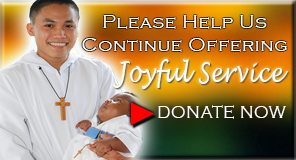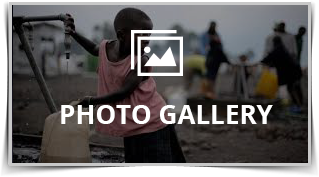Uganda – Kampala
History of the Mission 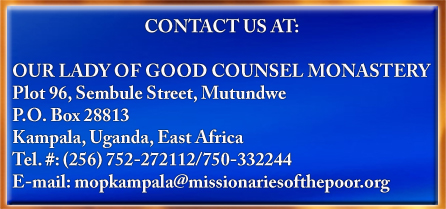
In the early 80’s and 90’s HIV/AIDS had become a big concern in Uganda. In fact, infection rates reached its peak in 1992 with some of the worst hit urban areas registering rates of over 30%. Resulting in many untimely and unfortunate deaths, it also had the added pain of leaving behind many orphaned children who no longer have parents to care for and rear them. According to official statistics, there were 1.77 million AIDS-orphans in the country in 1993—the highest figure in the world. Having been apprised of these sad facts, in the capital city of Kampala in particular, the Missionaries of the Poor began considering coming over to the country with AIDS-orphans in mind. This is in keeping with our stated mission of serving the poorest and the least in any country irrespective of caste, creed, race, nationality and culture.
Originally, the Institute sent Fr. Ambrose Kulandairaj and Br. Murray Goodman on an exploratory mission towards the end of May 1999. They were gladly welcomed by Emmanuel Cardinal Wamala, then Archbishop of Kampala, who opened doors to the Institute and its works. Shortly after that initial encounter, the Institute promptly dispatched our first set of missionary Brothers in the persons of Fr. Philip Selvaraj, Br. Marc Maurice, Br. Giovani Luna and Br. Kishore Ekka who set foot in Uganda on September 29, 2000 to establish our first mission in this hallowed land of the Ugandan Martyrs and the vast African continent.
First Foundation in the Land of the Martyrs
Upon their arrival, the small company of Brothers set about looking for a piece of land suited for our works as well as our monastery and formation center. In the meantime, they had to rent a house close to the Rubaga Cathedral in Kampala where they stayed for almost two years. In due time, they were able to identify two pieces: one at Mengo-Kisenyi, then the biggest slum in Kampala ridden with poverty, prostitution and crime, and the other at Mutundwe, just walking distance from the cathedral and a city suburb. The former came to be the place upon which the Good Shepherd Home was constructed, our first home for the homeless and destitute, which was opened in June 2002. Upon its establishment, it had an original intake of 80 residents who were primarily children which were disabled, mentally retarded, and AIDS-orphans. A small number of elderly residents whose family members were no longer able to care for them were also among them.
As for the latter, this became home to Our Lady of Good Counsel Monastery which was also blessed and opened at the same time that the Good Shepherd Home was blessed and opened. Even then, it had already begun to attract indigenous vocations which would eventually form the first cadres of our Ugandan and African community. In time, it would be expanded to include young men from Kenya who now make up the largest African unit in the entire Institute. Lately, Tanzanian vocations have also been added to our ranks.
Early Ministries and Outreach Programmes
With the Good Shepherd Home having been opened and in full operation from the first half of 2002, other activities began to take shape around the same time or shortly thereafter. Among them were as follows:
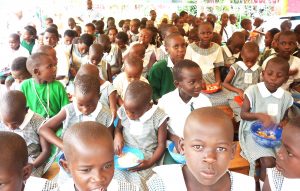 Feeding Programme for street and slum children, as well as refugee children from Burundi, DRC, Eritrea, Ethiopia, the Sudan and Somalia. This programme also benefitted IDPs from northern Uganda and those from Karimoja. There were about 180 of them altogether in the first group who were also given basic lessons in English, Mathematics and Values Education. After a year, they were sent to St. Athanasius Primary School in Kisenyi where they were eventually enrolled as regular students.
Feeding Programme for street and slum children, as well as refugee children from Burundi, DRC, Eritrea, Ethiopia, the Sudan and Somalia. This programme also benefitted IDPs from northern Uganda and those from Karimoja. There were about 180 of them altogether in the first group who were also given basic lessons in English, Mathematics and Values Education. After a year, they were sent to St. Athanasius Primary School in Kisenyi where they were eventually enrolled as regular students.
Medical outreach at Good Shepherd Clinic. At first staffed by a certified doctor that came thrice a week and a full-time nurse who was there every day, this clinic opened in 2003 and catered to a minimum of 60 outpatients each day from our slum neighbourhood in Mengo-Kisenyi. Economically challenged, these would not have had the chance at getting medical attention for lack of money. Their only options then would have been either to die slowly or go to a witchcraft doctor which would have produced the same end-result nonetheless.
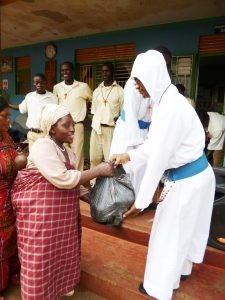 Food Lines. Conducted once a week, this programme also begun in 2003 with the slum dwellers of Mengo-Kisenyi for its primary beneficiaries. Made up of posho, beans and yellow corn, the food packages we distributed benefitted at least 80 families on a weekly basis.
Food Lines. Conducted once a week, this programme also begun in 2003 with the slum dwellers of Mengo-Kisenyi for its primary beneficiaries. Made up of posho, beans and yellow corn, the food packages we distributed benefitted at least 80 families on a weekly basis.
Catechesis/pastoral programme. This programme was conducted for children and youngsters that lived around our monastery in Mutundwe. Begun in 2004, it saw a minimum of 60 children and youths on Saturday mornings.



